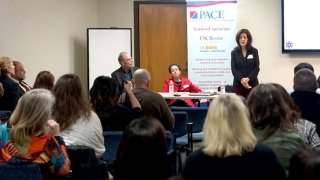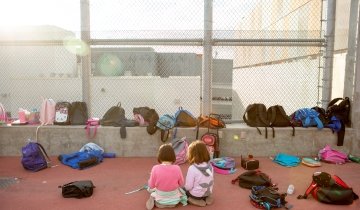In May 2016, on the Monday following USC Rossier’s two commencement ceremonies, more than 50 policymakers, philanthropists and researchers gathered bright and early across the street from the USC campus for a two-day conference. The goal? Hashing out a research agenda that would inform teacher policy in California and beyond.
USC Rossier Professors Julie Marsh and Katharine Strunk hosted the convening under the sponsorship of PACE — Policy Analysis for California Education. Founded in 1983, PACE is based at three academic institutions — the USC Rossier School of Education, Stanford University’s Graduate School of Education and the School of Education at University of California, Davis.
By late January 2017, Marsh and Strunk, along with USC Rossier graduate student Paul Bruno, had synthesized the proceedings into a brief that debuted at a one-day PACE seminar in Sacramento that once again addressed the broad landscape of education in California, including the latest research on school funding adequacy, teacher policies and cross-system alignment.
It might have been one week into the start of an uncertain presidential era, but it was also six years deep into an unprecedented era of synergy among California’s researchers, policymakers and practitioners. Together — and with the help of an organization like PACE — they are working to sustain a continued focus on improvement for students up and down the state and within each of its 1,100 districts.
RELEVANT, IMPACTFUL RESEARCH
“The California academic community is uniquely committed to research that is relevant to policy discussions” and to getting that research into the hands of decision makers, says David Plank, executive director of PACE. “Academic research has a much more direct and powerful impact on education policy in California than in any other state I know of.” Plank previously taught at universities in Pennsylvania and Michigan and is now based at Stanford.
One area of PACE’s focus has been the Local Control Funding Formula (LCFF), which dramatically changed the state’s 40-year approach to K-12 budget allocation. “Up until 2013, California had among the most — if not the most — state-centric education policy in the country,” Plank says. “The legislature controlled all of the money and basically made the rules for a thousand school districts.”
The new formula delegates much of that power to individual school districts. Plank says this shift also has significantly broadened the audience for PACE’s work. For instance, as districts struggle with how to facilitate meaningful stakeholder engagement — which is required under LCFF’s accountability system, the Local Control Accountability Plan (LCAP) — or whether LCFF is complementing or conflicting with Common Core State Standards (CCSS), they benefit from studies conducted by PACE’s academic partners.
In spring 2017, Marsh, Rossier’s faculty director at PACE and an expert on accountability and instructional reform policies, was among a team of researchers that shared their emerging findings on LCFF at a PACE forum in Sacramento. She was also part of another team that presented research on the most recent PACE/USC Rossier Poll, which found that while public interest in participating in school goal-setting and resource allocation decisions was high among California voters, actual participation — such as voting in school board elections or attending board and LCFF meetings — lagged significantly. Now in its sixth year, the annual poll addresses a wide range of topics, from perceptions of teachers and public school performance to standardized testing.
Insights gleaned from USC Rossier research and the latest poll could drive novel approaches to foster engagement, Marsh notes. “We hope to provide some policy guidance and an understanding of who’s participating and why.”
Marsh has co-authored several papers and policy briefs on lingering challenges in LCFF implementation. While superintendents and educators remain enthusiastic about local control (see “A Tale of Two Districts,” p. 10), additional clarity is needed around the LCAP’s purpose, as well as how districts are interpreting the law’s equity mandate.
“There needs to be some real hard thinking about whether the LCAP can accomplish all of its goals — engagement, strategic planning and accountability,” Marsh says. “There may be more innovative approaches, such as piloting different methods to achieve those goals.”
Thanks in part to ongoing research by PACE and USC Rossier, and the statewide discussion it has helped generate, LCFF is in its third iteration as lawmakers continue to refine the policy based on study data and district feedback.
THE CALIFORNIA WAY: FROM LOCAL CONTROL TO A COLLABORATION OF CORE DISTRICTS
While the research suggests that LCFF is still a “work in progress,” Plank highlights one of its key strengths. “Rather than identifying who’s doing badly and either punishing or sanctioning them, it’s identifying who’s facing challenges and trying to provide them with support,” he notes. “That’s quite different from other states.”
According to postdoctoral fellow Michelle Hall PhD ’16 — who wrote her dissertation on the new law — “LCFF and LCAP are unique. The only state with something similar is Hawaii, but it has only one school district for the entire state.” She says that, since California implemented the new model, other states are watching and are interested in trying similar policies.
“It’s not as though the ideas in California are brand new, but they are working together here in a way that stands out,” Plank adds.
California State Board of Education Vice President Ilene Straus EdD ’00 explains one of the reasons the state is forging its own path. “We have about $88 billion in our state education budget, of which $8 billion — or approximately 10 percent — is federal dollars. So our bias is that 90 percent of the budget is state money. And we have a really big state.”
Straus explains that California continues to try to align with the federal government, but its priority is on what works best for California students.
Plank adds that California was curiously often at odds with the U.S. Department of Education under the Obama administration. When the state was in a pilot phase with Common Core State Standards the federal government expected California to use the old standardized tests. “We would have been administering tests that were not aligned to our new standards,” he says. “California refused.”
The California Office to Reform Education (CORE) — a consortium of eight large districts across the state — sought and obtained a waiver from federal policy to implement a new system to evaluate school performance rather than using the accountability systems under the former No Child Left Behind Act (NCLB), now replaced by the Every Student Succeeds Act (ESSA, see “Influencing the Conversation”).
“A lot of folks think of CORE as early adopters of an ESSA-like accountability system,” says Marsh, who, along with PACE colleagues, has been conducting research to support CORE’s efforts. “We’ve been documenting their experiences early on in adopting this new policy as a way of helping the rest of the country see some of the issues that might come up when you implement a system different from what we had in the past.”
One of the distinctive aspects of CORE’s system of measuring school performance, she says, is not just inclusion of English-language arts and mathematics achievement but also nonacademic measures, such as social-emotional learning. Unlike NCLB, CORE’s system also moved away from sanctions as a consequence for low performance to a more collaborative, capacity-building approach, Marsh adds.
STRATEGIC ADVANTAGE
Besides the quality and breadth of research coming out of USC Rossier, the school location provides PACE with another significant advantage, Plank says. “Strategically, Rossier is actually, in some respects, the key to PACE’s future because Southern California is where the kids are and it’s where the issues arise,” he adds, noting that Los Angeles alone has more than one-quarter of the state’s K-12 students.
“As we move into this new LCFF era, the importance of learning from our experiences and disseminating what we learn to other districts, to other educators, is only going to increase,” he says. “We have a really solid foundation with the work Rossier does here, with the work we do at PACE, and I think we’re leading the way into the future.”




